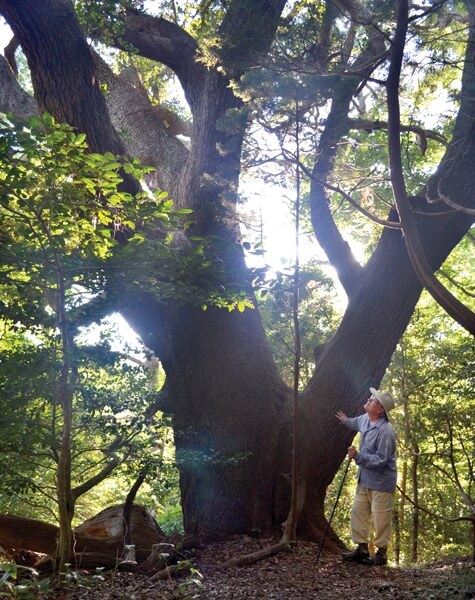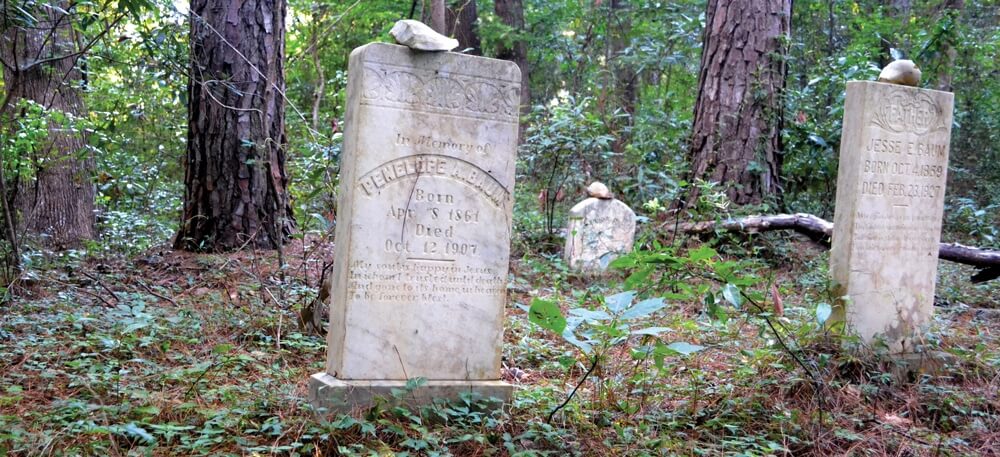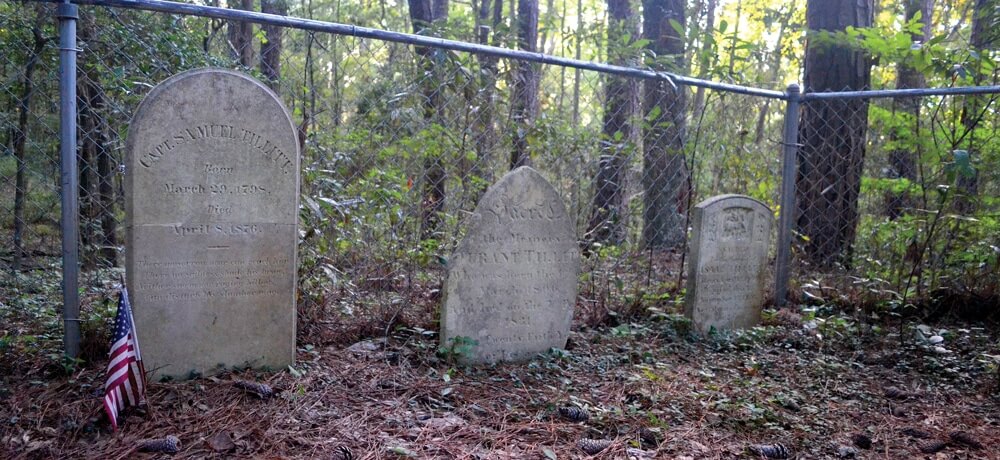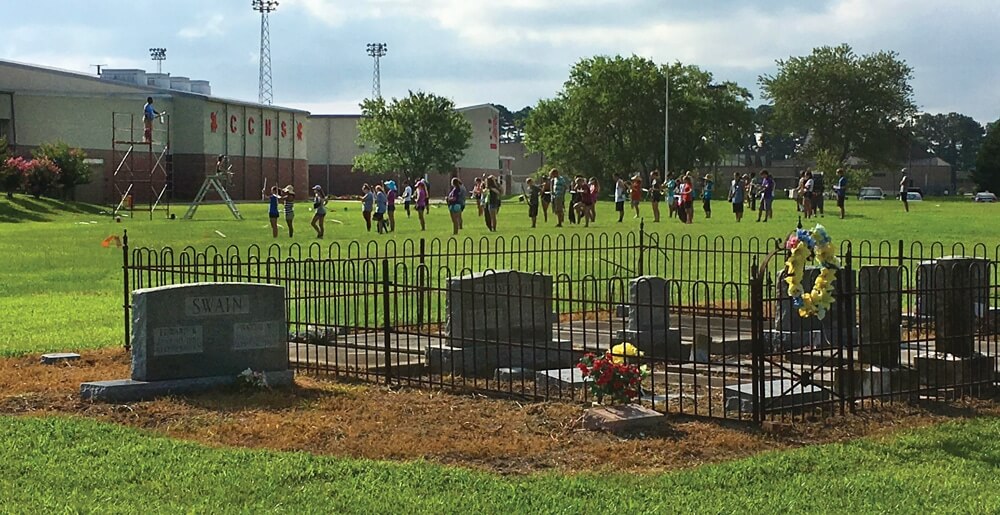Buried in Time
The barely discernible path veers off the dirt road in Nags Head Woods, up along a high ridge. Felled trees and heavy underbrush often block the trail, forcing hikers to search for signs of foot traffic on a carpet of pine needles and leaves. As they climb higher, glimpses of the Roanoke Sound glitter silver-blue far below the ridge. Then the ground plateaus, revealing old footings and brick chimneys — remains of homes.

Cola Vaughn stands beside the “Baum tree” as he explains that baum is the German word for tree. Photo Katelin Kight
Finally, among the majesty of old live oaks, cypress, and red bay trees, an opening. There is the Baum family cemetery, white marble headstones still intact and legible. A large whelk shell, home to numerous long-legged spiders, perches on each headstone.
Samuel J. Baum, born Sept. 6, 1854, died Sept. 29, 1860. Nancy Baum, born Aug. 6, 1824, died Oct. 18, 1886. Jesse E. Baum, born Oct. 4, 1859, died Feb. 23, 1927. Penelope A. Baum, born April 8, 1861, died Oct. 12, 1907. Jessie James, son of Jesse and Penelope. Born June 20, 1886, died June 26, 1886.
Placing shells on tombstones is a tradition that some say symbolizes the connection of the spirit to water and the restful sounds of the ocean. Others believe the shells symbolize protection in the afterlife, or simply that the departed person has not been forgotten.
Members of a small community in this maritime forest spent their entire lives — or, tragically, only a few short days — on this ridge. They farmed and fished and grew gardens in their yards. They had pigs, horses, and chickens. They traveled back and forth between Nags Head and what is now Duck on a rugged road that aligned with the trail leading to the cemetery.
Decades later, a descendent of that same family, Diane Baum St. Clair, donated a portion of her family’s land in Nags Head Woods to The Nature Conservancy, which owns and manages 1,200 acres of the preserve, and she sold the rest of the huge tract at a reduced price to the town of Kill Devil Hills, where the town built its municipal buildings. A dazzling character, who in her lifetime, worked as a model, a ferryboat operator, a psychologist, and a realtor, St. Clair died in March 2003 at 94 years old.
But in that quiet cemetery where St. Clair’s ancestors are buried, those that came before her are lost to eternity, barely remembered except for some letters carved in marble slabs. A determined few still come to visit the remote location, mostly in the winter when the weather has cooled and the trail is less covered. Otherwise time seems to have forgotten Jesse and Penelope Baum’s little cemetery. It does not appear to be tended, yet it is well preserved in its serene setting. Not far from the graveyard is a live oak with a girth that would make a redwood proud. Stout branches on other nearby live oaks reach far into the forest, bringing out repressed yearnings to climb a tree. Nearby, thick overgrown vines inspire visions of Tarzan swinging through the forest.
“It is kind of romantic, in a Heathcliff-y kind of way,” says Cola Vaughn, a real estate broker and history buff from Nags Head as he escorts a small group to the cemetery one late afternoon.

Whelk shells adorn the Baum family’s headstones deep in Nags Head Woods. Photo Katelin Kight
Back on the dirt road, one of the two Tillett family cemeteries in Nags Head Woods can be seen off to the right behind a wire fence. Although there are some faded silk flowers in vases, distant relatives have clearly not been looking after the graves. It’s no wonder — Dolly Tillett, who was born April 10, 1776, died on August 20, 1829 so it would be hard to find fault in faded memories.
Such is the case with many cemeteries on the Outer Banks. Along with the tidy, manicured cemeteries and family plots, there are some that have been neglected for decades, with headstones barely visible among overgrown weeds and decaying tree limbs. Some have headstones that have been tossed awry by storm-driven tides and winds, with no one available to right the indignity. Others are bordered by eroding shorelines that are undermined by constant wave action. In the worst cases, caskets have floated to the surface or even been strewn about and destroyed during storms.
Yet the Outer Banks, colonized for more than four centuries, has many cemeteries that are revered as places of beauty and spirituality, where the living can visit to honor their ancestors or just stroll around to marvel at the mystery of life and death.
Whether it’s a lovingly tended family graveyard, a well-maintained community cemetery, or a neglected bygone of the past, what all burial grounds on the Outer Banks share is history — of an individual, of a family, of a place.
In the 1999 book Sacred to their Memory: The Dare County Cemetery Survey, Amy Midgett Gamiel and Lois Johnson Meekins identify local graves of deceased people dating back to the 1700s, while also listing their life spans and where they were buried. Some of the largest cemeteries — Cudworth Cemetery in Wanchese, Hill Top Cemetery in Colington, Roanoke Island Memorial Garden Cemetery on the north end of the island, Mt. Olivet Cemetery in Manteo, and the Austin Cemetery in Kitty Hawk — have thousands of listings. Cemeteries from Stumpy Point to Corolla to Rodanthe to Ocracoke include surnames of family branches that have intertwined over vast spans of time and geography on the Outer Banks, through birth and through marriage: Miller, Scarborough, Meekins, Davis, Austin, Sawyer, Twiford, Beasley, Harris, Beecham, Fearing, Daniels, Etheridge, Baum, Tillett, Collins, Dough, Gaskins, Payne, Cahoon, Peele, Owens, Spencer, Moore, Gray.
Some names, rumor has it, go back as far as the Roanoke colonists and the infamous 1587 Lost Colony. The most common name of all, including all its iterations, is Midgett — it takes up two-and-a-half pages in the book. It’s not unusual for one community to have several — even numerous — Midgett family cemeteries.
Only one name in the index is listed as a slave: “Pomp,” who is buried in Stumpy Point Cemetery. His record states that Samuel Midgett sold him in 1811 to Elizabeth Mann. But many of the African-American families from Manteo have surnames that may also have origins in slavery.
With rising seas along the Outer Banks, cemeteries have become more threatened by overwash, elevated ground water, and shoreline erosion. In “Cemeteries in the Sea” by William J. Neal and Orrin H. Pilkey, the authors say that sound side cemeteries are being undermined or breached. One example they cite is Portsmouth Island, the abandoned village south of Ocracoke where a community cemetery is almost completely lost.

One of the old Tillett family cemeteries is protected by a wire fence in Nags Head Woods. Photo Katelin Kight
“Located on the back side of the island, the sea level rise has flooded what was once dry land from the sound side, and the only evidence of the cemetery is a few remnant stones in the salt marsh,” they write. “Clearly, this 19th century cemetery was not originally placed in the marsh, so its current location is evidence of sea level rise.”
The Salvo Community Cemetery, often called the Midgett Cemetery, has about 25 gravesites located near the parking lot in the middle of the National Park Service’s Salvo day-use area. The cemetery survey book, however, includes records of 32 stones.
“It’s suffered some pretty bad erosion over the past few years,” says Jenny Creech, president of the Hatteras Island Genealogical and Preservation Society.
Creech says that the graveyard has not been maintained over the years, and funding options have been limited because it’s a private cemetery. According to Creech, at least two tombs have been exposed.
One of the graves in the cemetery is around 144 years old. Wooden coffins from that time can be vulnerable in wet locations, so the Preservation Society has obtained approval to build about 200 feet of bulkheads and/or temporary sandbags to protect the shoreline there.
Under the umbrella of the nonprofit Rodanthe-Waves-Salvo Civic Association, the Preservation Society is seeking to raise funds online through GoFundMe for the bulkheads and the sandbags. Meanwhile, Creech says she has put up a fence and a “private property” sign to keep people from inadvertently crossing through the cemetery to get to the sound.
As strange as it might seem to some from out of state, it is not unusual in northeastern North Carolina to come across a graveyard just about anywhere — including people’s yards.
In North Carolina, as long as basic regulations are met, there is no prohibition from burying a person on your property. With more land being developed, sometimes burials will be relocated to a communal cemetery, says Allen Dew, who maintains a cemetery census in numerous North Carolina counties. But the high cost of relocation — $1,000 or more per grave, he says — has spurred more developers to just fence off the cemetery and build around it. Unfortunately, there have also been instances where developers have been accused of building right over or through gravesites.
For the Kight family, a solution to development around their Lindsey family plot in Barco has worked out just fine, says Rodney Kight, who has five generations of family buried on the front grounds of Currituck High School.

The Lindsey family cemetery is still maintained by their descendants in a fenced off area located on the front grounds of Currituck High School. Photo Rodney Kight
The family sold about 50 acres of property to the county around the early ‘70s, he says, which precluded any more family members from joining their deceased relations. But Kight’s 84-year-old mother, Mary Kight — a Lindsey by birth — often brings flowers on special occasions to family members buried in that fenced-off plot.
“She probably is much more attentive to it than anyone,” Kight says.
Old Currituck County families are not to be outdone by old Dare County families in their deep roots and their devotion to community and family. Not only did Kight’s grandparents live one house from the graveyard, both he and his mother were raised about a quarter mile away from the spot. In those earlier days, Kight says, when people died, “you put ‘em in the ground,” right there on your land.
Kight’s grandmother, Edna Walker Lindsey, died on her 100th birthday, “to the day,” he says. She was a skilled seamstress, renowned for making little animals out of fur that she would sell for $10 to $15. “She was a hustler,” Kight recalls. “She was pretty self-sufficient…sharp as a tack.” Her husband, Nathan Walker Lindsey, died at age 61, probably from cancer.
And it’s a comfort to his mother to be able to go down the road to visit her parents’ graves and honor their memories. It’s what family members did in her generation, before all the land started being sold off.
Even back in Nags Head Woods, where four graveyards are tucked among trees that did not exist when these burials took place, strangers will still veer off the dirt road to look at the headstones and contemplate what came before. For a slab of stone with a name carved on it, few historic remnants bear a message as simple, compelling, and powerful: This was a life. Someone lived at this time, in this place, and with this family. ♦
Catherine Kozak has been a journalist and writer on the Outer Banks since 1995. She enjoys running in Nags Head Woods and wonders how any of its residents back in the old days were able to withstand its vicious summertime bugs.
Catherine Kozak has worked as a writer and reporter on the Outer Banks since 1995. She lives in Nags Head and enjoys running in the woods with her dog, Rosie.





